Which districts could return relief dollars to the Feds?
The Sept. 30 ESSER deadline is fast approaching. Which districts might miss it?
Schools have more staff than ever. Are kids benefiting?
Most districts now have more staff than ever before. Per usual, Edunomics Lab asks: Is it working? Are students benefiting?
30-Min Webinar: Are students benefiting from the rising costs of Special Ed?
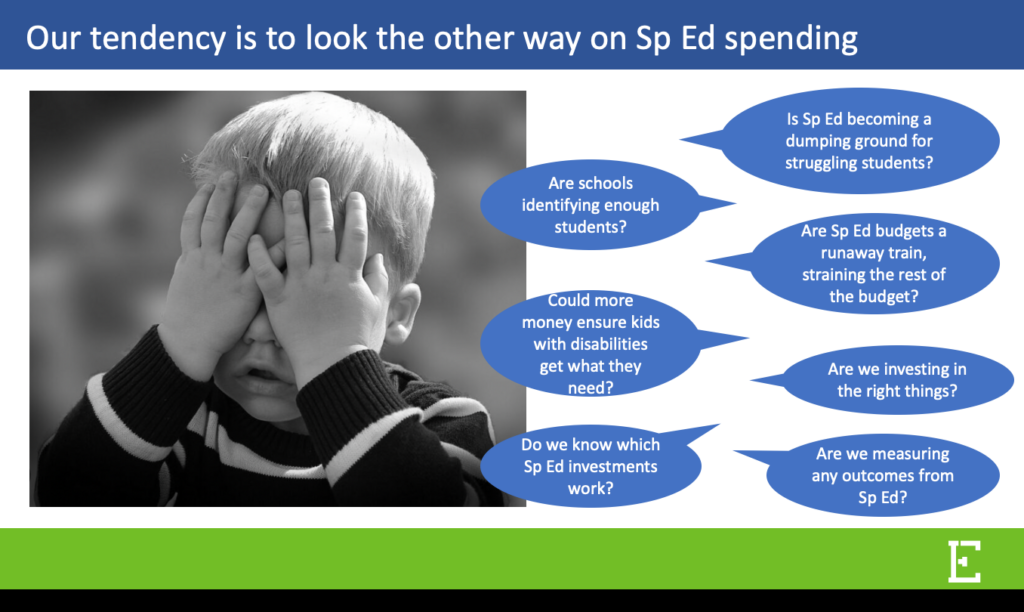
In this 30-minute webinar, we share findings from Edunomics Lab’s analysis of new Special Ed spending data to better understand the extent to which rising identification rates and staffing increases deliver value for students.
Why WA school budgets are getting tighter, and what can be done about it
In the Washington State Standard, Marguerite Roza and Ash Dhammani write that strategic financial leadership is more critical than ever to help communities understand tradeoffs and ensure WA state’s students get the most for every dollar.
Can vendors help our schools?
Optimism around the ed vendor space is running high.
Widespread teacher shortages are over (mostly). Conditions are changing rapidly
It’s more important than ever to track real-time data.
California’s school funding crisis has arrived. Here’s how leaders can dig out
With pandemic recovery funds drying up, state funds tightening, and fewer students bringing fewer dollars, many districts have no choice but to reevaluate investments, downsize and likely reduce staffing.
With a Fiscal Cliff Looming, States Must Ensure Districts Maximize Every Dollar for Students
These five levers are low-cost and popular on both sides of the aisle.
Is it too late to protect what’s working as the cliff hits districts?
Next year’s school district budgets will be locked in this spring. After that, influencing spending for 24-25 gets a lot harder.
30-Min Webinar: Six months remain on ESSER. What’s left to do? What worked? What didn’t? What happens when it’s gone?

We take stock of what districts did and didn’t accomplish with the money, what’s left to do, and what happens when the money is gone during this 30-minute webinar.
Winding down ESSER. Is it working? What’s left to do?
Just 6 months remain on this massive federal program. While there’s still work to be done, we can already see it’s legacy taking shape. Here are a few highlights…
Bringing communities along during painful budget choices
For leaders facing tight budgets, there are better and worse ways to handle the next several months.
Closing schools: How much money does it save, and is it worth it?
School closure decisions are never easy. In this EdSource commentary, Roza and Dhammani outline several factors districts should consider in order to bring transparency to the process and ensure all students are served well.
School Boards Face Their Most Difficult Budget Season Ever

How can school board members bring their communities along in challenging financial times? Marguerite Roza and Laura Anderson weigh in at The 74.
State Revenues Outlook

This analysis provides estimates of year-over-year changes to state General Fund revenues.
Who decides what to cut? Technically school boards do
School boards face tough tradeoffs as they decide what to keep and what goes away when federal relief funds dry up. Here’s what we’ve been learning about how boards engage in making financial decisions.
30-Min Webinar: What happens to K-12 nonprofits and vendors when ESSER ends?

In this webinar we look at what nonprofits and vendors should know about the end of ESSER and market changes in the coming years.
30-Min Webinar: Mayday… Mayday… Who Will Answer the Distress Signals Appearing in Some Districts’ Data?

This webinar looks at ways to read the distress signals in district data, raise the alarm, and take steps to help “Mayday” districts.
Mayday…Mayday…Distress signals are appearing in some districts’ data
A quick look at a district’s data can show whether it’s chipping away at learning losses, how quickly ESSER is being spent down, what’s happening to enrollment and more. In a few districts, some of the numbers amount to a distress signal.
30-Min Webinar: The ESSER Cliff: What state and district leaders in CT, MA, NH & RI should know as ESSER funding ends

This webinar shares an analysis of the pending ESSER cliff in districts in 4 New England states and key factors in protecting what matters most for students & district financial health.
The Fiscal Cliff: Exploring the Impacts on Equity

In this webinar hosted by the National Comprehensive Center, the Edunomics Lab team explores how the end of ESSER funds may affect equity
Where and how does inequity creep in?
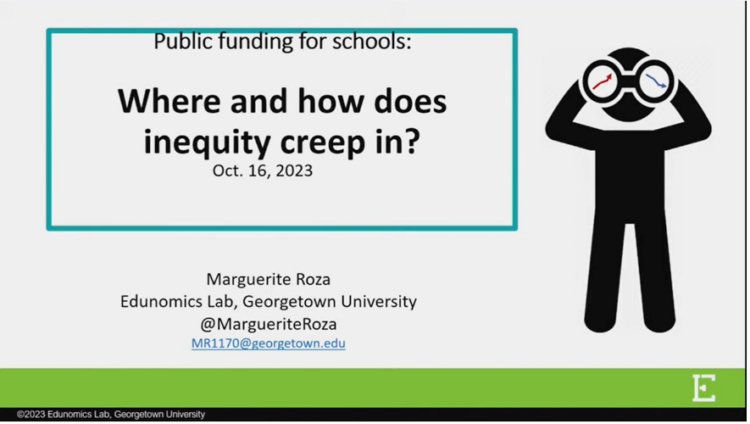
Marguerite Roza gave this presentation as part of panel on “Understanding Educational Opportunity Gaps,” at the University of Virginia School of Law’s launch of the Education Rights Institute.
30-Min Webinar: Districts now have more staff than ever. And fewer students. What happens next?

With the end of ESSER looming, and tighter state budgets, districts know they can’t afford their expanded labor force. Is now the time to rethink the age-old strategy that the best way to serve students is to add more staff?
Educators Beware: As budget cuts loom, now is NOT the time to quit your job

The staffing-enrollment mismatch spells financial trouble for school districts, and an end to the hiring spree of the last few years, write Katie Silberstein and Marguerite Roza at The 74.
30-Min Webinar: Make it or break it! This spring’s district budget choices matter tremendously for the years ahead.

Never before have district leaders faced such competing priorities: spend down relief dollars in ways that bring value for students, while also bracing for budget gaps unlike any in history. In this webinar we share what we’re seeing in district balance sheets, and outline key issues for this spring’s budget discussions.
The Massive ESSER Experiment: Here’s what we’re learning.
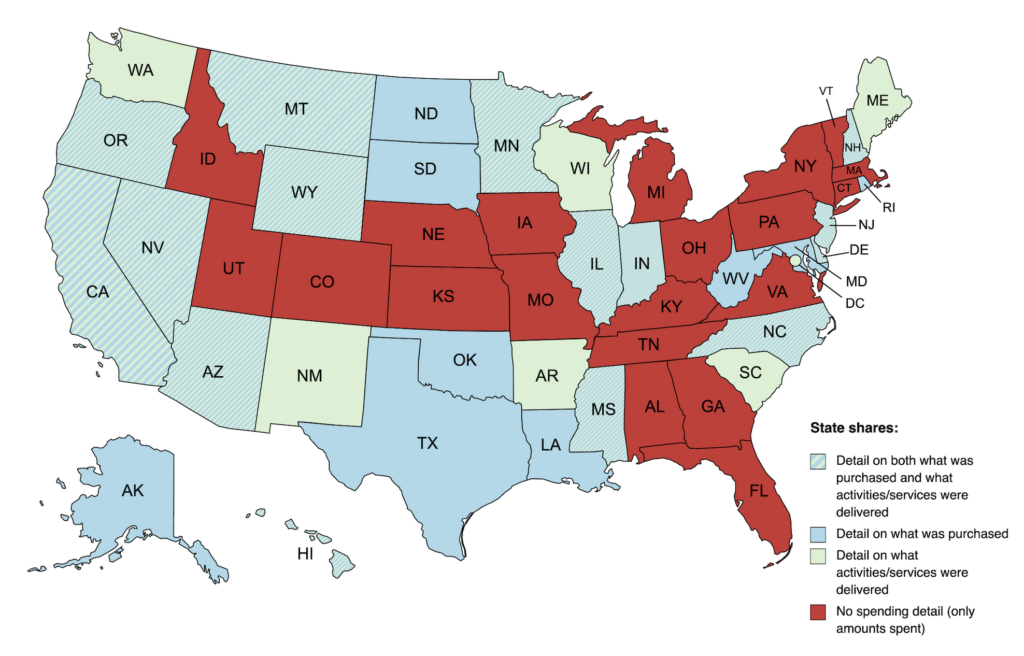
With 18 months to go before ESSER ends, Katherine Silberstein and Marguerite Roza take stock of how school districts have spent their funds so far, at Education Next.
Districts face deep financial pain in the next two years. Decisions made this spring will determine how it all plays out.

Marguerite Roza suggests keeping an eye on six critical issues during this spring’s district budget discussions, as decisions made there will determine what happens on teacher layoffs, school closings, program cuts, and more.
Sharing tough financial news? Odds are you’re doing it wrong
Edunomics Lab has commissioned lots of messaging research on district finances. Here’s some of what we’ve learned about sharing tough financial news in a way that doesn’t erode trust with staff and parents.
The Stakes Are Only Getting Higher For Pandemic School Aid Spending

Higher spending in the final months of ESSER makes for deeper cuts come the 2024-25 school year, writes Marguerite Roza in Forbes. Meanwhile, students are still far behind where they should be.
ELab-U: Smart Money for School Leaders

Smart Money for School Leaders is a collection of education finance instructional modules developed by Edunomics Lab, Georgetown University designed to provide hands-on finance skills for school leaders.
Tough finances ahead for districts. Will states come to the rescue?
Come September 2024, when ESSER runs out, districts will need to adjust annual spending down by $60B. What might that mean for employee layoffs?
Federal Data: Schools Have Been Adding Teachers Even As They Serve Fewer Students

For schools to improve their services and respond to student needs, it’s important to be precise about the exact staffing challenges they face, writes Chad Aldeman at The 74.
Let’s Pay Parents to Help With Learning Recovery

Some school districts are flush with cash, but can’t find enough people to fill their open roles. In this Education Week commentary Chad Aldeman asks: what if schools engage families to help make headway on student recovery efforts?
District Budget Decisions & Labor Implications Tracker
This working document aggregated district choices in response to the economic downturn and budget implications related to cuts or labor impacts.
Districts play a starring role in school finance
For decades, the field of education finance has focused heavily on states (revenues, funding formulas). Now that attention is shifting to school districts’ spending choices, especially regarding federal ESSER funds.
30-Min Webinar: Is it too late for districts to redirect ESSER commitments to tackle learning gaps?

The school year had already started when test scores emerged showing deep gaps in learning. Is it too late for districts to adjust their ESSER commitments to boost recovery efforts? In this webinar we share our latest look at ESSER spending and suggest ways that districts can redirect, and in some cases refocus, their federal relief funds to respond to emerging data on what students need most.
Time to Change the District Budget Dance

Getting maximum value from available dollars is imperative, and may require some changes to the traditional budget process, writes Marguerite Roza in School Business Affairs Magazine.
Why Are Fewer People Becoming Teachers?

What caused the decline in teacher-preparation enrollments and completions? Until we diagnose the problem accurately, we won’t be able to devise solutions to fix it, writes Chad Aldeman in Education Next.
On a Per-Student Basis, School Staffing Levels Are Hitting All-Time Highs

Schools in 46 states effectively lowered their teacher-student ratios by continuing to hire while enrollment has dropped, writes Chad Aldeman at The 74.
Financial Innovations During COVID Show Schools Can Be Nimble When They Have To

When districts break out of deeply ingrained expenditure habits, it’s a big deal. At The 74, Roza & Silberstein share four financial practices that emerged during the pandemic that we hope will last.
Back to school… for school board members?
School boards are facing financial conditions unlike any before. We think practical, strategic financial skills will be particularly useful in the coming months.
What Goes Wrong When Some School Board Members Don’t Understand District Finances?
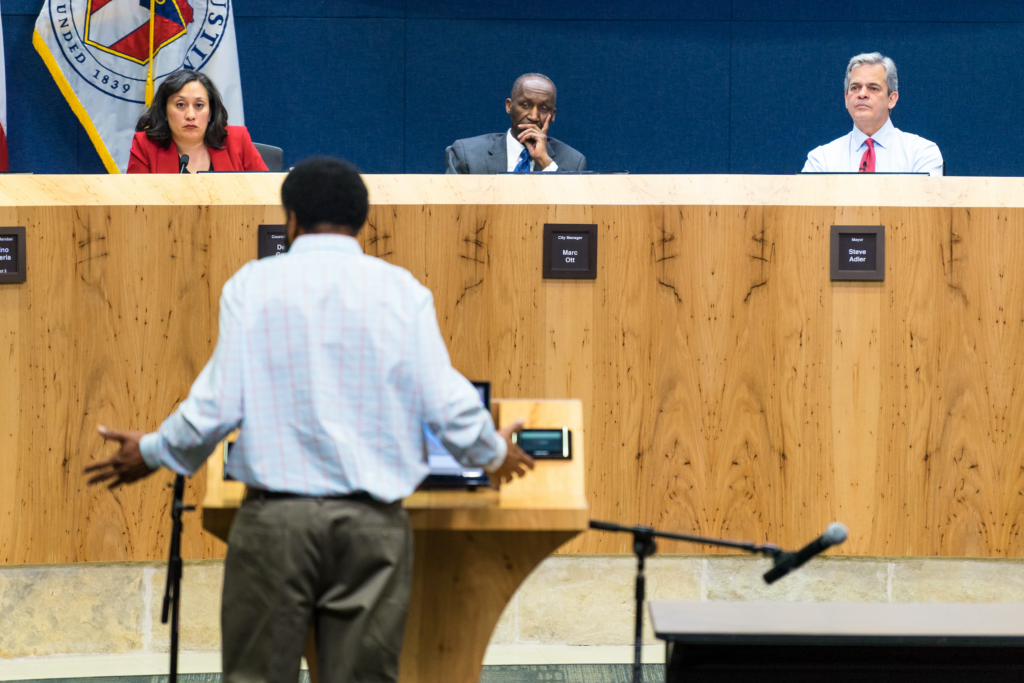
A lack of school board financial expertise is especially problematic as members wrestle with the pressures of enrollment declines, inflation, and the temporary nature of federal relief funds, writes Marguerite Roza in Forbes.
30-Min Webinar: The financial forecast is in! School district budgets are headed for a wild ride.

School district budgets are about to be hit by a powerful wave of financial pressures. In this webinar we walk through a mix of factors, explain how – and when – they’re likely to hit district budgets, and discuss how district and state leaders can make smart decisions now to prepare.
A perfect storm is brewing for K-12 school district finances
Districts across the country have just inked budgets that reflect more growth in spending than any time in the past. And yet the financial outlook has never looked gloomier.
ESSER is fueling one-size-fits-all strategies. Let’s use data to deliver more targeted efforts.

The pandemic left schools with mammoth challenges. Using data to zero in on problem hotspots makes tackling them much more manageable. That should happen now, write Marguerite Roza and Ellie Roza, while federal relief money is still on the table.
30-Min Webinar: How can districts measure learning loss recovery costs?

In this webinar we share “The Calculator,” a new tool that estimates lost learning time in more than 8,000 school districts and how much a district would need to invest to get students back on track.
New Learning Loss Calculator Estimates COVID Slide, Costs of Catching Kids Up, in 8,000 School Districts

The Edunomics Lab team used the results from new research to build a calculator tool that estimates lost learning time in more than 8,000 school districts and what it will cost to get students back on track. In this commentary published by The 74, the authors urge district leaders to take stock of where their students are, and invest federal relief dollars now in ways that work for students.
What Are Districts Using Their Federal Relief Money for? How Fast Are They Spending It? How Much Is Left? New Interactive Database Has Answers

Because Congress directed federal relief funds to flow through states, districts file for reimbursement as the funds go out the door. In an analysis published by The 74, the Edunomics Lab team shares early results of tracking the actual spending data, district by district.
Inflation Will Put Districts in a Pickle

With contract negotiations pending and federal relief funds complicating the labor market, how can school districts respond to rising inflation pressures? In this Education Next commentary, Marguerite Roza suggests options to help mitigate long-term fiscal impacts.
Responding to a Tight Teacher Labor Market

In this article in School Business Affairs Magazine, the authors outline the types of innovative compensation strategies some districts are using to attract and retain talent in response to a tight labor market.
Talking about ESSER: Ways to Build Community Trust and Keep the Focus on Results for Students

Laura Anderson and Marguerite Roza map six ways district leaders can communicate about and help make the most of their ESSER investments.
There Is No ‘Big Quit’ in K-12 Education. But Schools Have Specific Labor Challenges That Need Targeted Solutions

There is no ‘Big Quit’ in K-12 education. But schools have specific labor challenges that need targeted solutions, writes Chad Aldeman in The 74.
30-Min Webinar: Will We Ever Know How ESSER Is Being Spent?

In this webinar we look at how federal relief money is being tracked and what we’re learning as a result.
How COVID-19 Ushered in a Wave of Promising Teacher Pay Reforms

This brief outlines the types of teacher pay innovations popping up in the midst of the pandemic, explains why they matter, and highlights some of the districts trying them. It remains to be seen whether some of these innovations may live on beyond the pandemic if district leaders find them effective.
An Idea For This Moment: Districts Can Pay Families To Help Get Students And Schools Back On Track

Sharing a portion of federal relief funds with families offers school districts a chance to re-engage students and parents and sends a message that they are valued partners in solving problems that directly affect them, writes Marguerite Roza in Forbes.
The scarcity mindset that plagues education news

Education finance is a messy topic for journalists, and this last year has made it especially hard to neatly summarize the issues. at Kappan, Chad Aldeman cautions that reporters who focus exclusively on questions of scarcity may perpetuate a false narrative and miss the biggest education finance story of the last decade: How are district leaders spending their new financial windfalls, and what effect is it having on students?
Decrease in Student Enrollment: Forcing Tough Decisions

While the infusion of federal relief aid has temporarily protected most school districts from the fiscal impact of enrollment losses, this article in School Business Affairs magazine highlights why it’s important to proactively plan now for how to maintain services once those supplemental funds are gone.
Do leaders have the financial skills needed for this moment?
Now more than ever, the education system depends on district leaders having financial fluency and the skills to leverage resources on behalf of students.
Fewer students are attending public schools. What does that mean for the future of school district finances?

This analysis compares the amount of money school districts will receive from the two largest federal COVID relief packages (ESSER II and III) versus their projected budgetary declines due to enrollment losses.
There’s a fiscal cliff coming, and some districts appear hell-bent on making it worse

Districts are right to worry about a fiscal cliff when federal relief aid runs out, cautions Marguerite Roza, but leaders have options beyond handwringing.
From Paying Parents to Transport Their Kids to School to Calling Out the National Guard — Innovating in the Face of a Bus Driver Shortage

How districts react to unusual labor challenges like the bus driver shortage may tell us whether they can adapt to meet the moment and which, if any, will consider adopting innovations common in industries outside of education.
Districts Like San Diego Could Be Locking Themselves Into Painful Cuts Down the Road

Rather than making long-term commitments that can lead to financial stress down the road, Chad Aldeman suggests there are other ways for districts to both raise pay and build capacity.
Maintenance of Equity: A New Provision with Big Implications for District Budgeting

Chad Aldeman and Marguerite Roza explain how an expansive interpretation of a new federal provision could have unintended consequences.
What will MoEquity mean for district budgets?
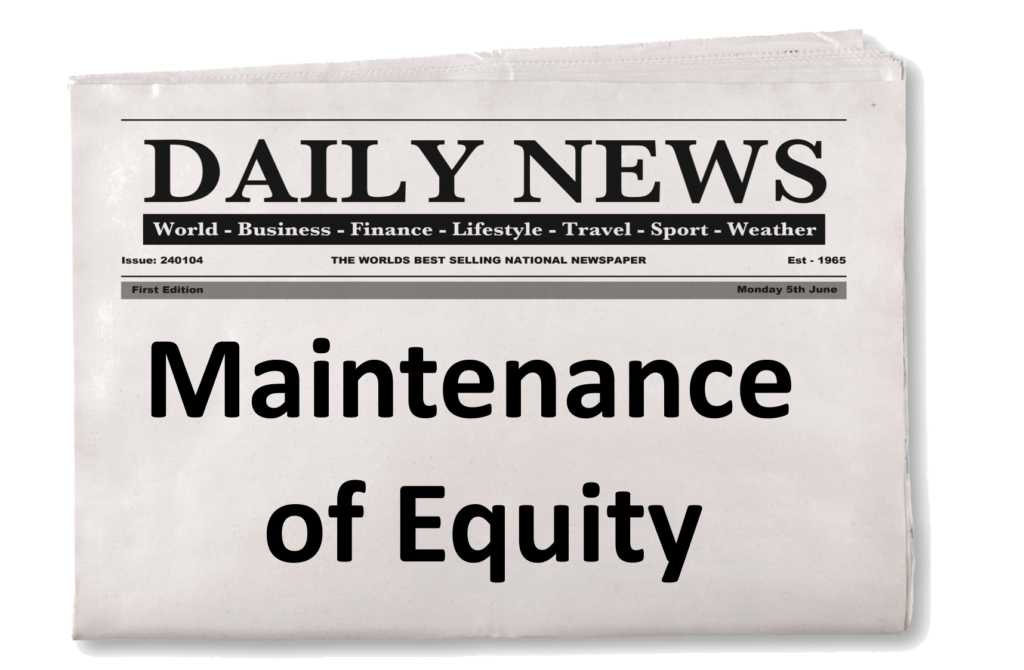
In this webinar Marguerite Roza and Chad Aldeman discuss the new guidance for the maintenance of equity provision and what it would mean for districts faced with implementing it.
Communication Template for Principals on Use of Federal Relief Funds

Based on messaging research on how district staff, principals, teachers, and parents engage with and react to information about school finance, this template will help principals engage their community in a way that cultivates trust and helps make the most of the federal relief dollars.
Smart ways to cover the coming ‘year of ed finance’

Marguerite Roza offers six tips for reporters on covering how school districts choose to spend $122 billion in flexible American Rescue Plan funds, the biggest onetime federal payout to schools ever.
Teacher Dissatisfaction May Be High, But So Are Retention Rates

Across Washington state, public schools retained a higher percentage of teachers last year than they do in normal years. That’s important information for school district leaders as they decide how to spend the windfall of federal relief funds headed their way.
By Paying Stipends to Schools’ Teaching Staff, Districts Can Add Learning Time Without Breaking the Bank

In this commentary at The 74, Chad Aldeman shows how offering current teachers stipends to take on more hours could provide students with additional learning time without locking districts into long-term financial obligations.
30-Min Webinar: Teacher Labor Market Trends and What They Mean For District Budgets

In this webinar, we share what we’re learning from the data on teacher turnover and discuss how the current fiscal conditions should inform staffing and salaries as districts navigate budget and hiring season.
Remote or in Person? Underspending or Running Deficits? What School Reopening Decisions Mean for District Budgets

An Edunomics Lab analysis finds that while many districts are struggling financially, those that have remained mostly or entirely virtual have actually been able to save money. Some are even on pace to run surpluses this year.
30-Min Webinar: Open Or Remote? What It Means For School District Budgets

In this webinar we explore how district spending varies depending on whether schools are remote or in-person (is the financial focus on remediation? or on reopening?), and look at what new federal relief dollars could mean for district finances.
During the pandemic, lost education jobs aren’t what they seem

In this Brookings Chalkboard blog, Chad Aldeman digs into BLS data to find that recent public education job losses stem from a slowdown in hiring, not layoffs or a surge in worker turnover.
Proceed with caution: With enrollment drops, states are looking to hold district budgets harmless

In this brief, Hannah Jarmolowski and Marguerite Roza outline what states need to weigh when it comes to hold harmless provisions.
Upcoming webinar, fun with charts & more
What’s going on with district finances? The answer: it depends. Districts that have been operating in-person since the fall have faced new costs, while districts that have been fully remote for the last year appear to be saving money on staff and facilities.
Lessons from Spanish Flu — Babies Born in 1919 Had Worse Educational, Life Outcomes Than Those Born Just Before or After. Could That Happen With COVID-19?

Chad Aldeman shares an analysis of the life trajectories of babies born during the Spanish Flu, and possible implications for the economic impacts of COVID-19.
30-Min Webinar: Impacts of Enrollment Shifts and Learning Loss on District Finances

In this webinar we look at the implications of enrollment losses and state revenue declines for school district budget decisions, including hold harmless policies that protect districts from losing state funds. We also consider different district investment options to address learning loss with new federal funds.
Tips & tools to navigate ed finance in 2021
2021 is guaranteed to be tumultuous for public education finances! As we march forward, Edunomics Lab has several resources to help leaders navigate the unstable landscape ahead.
Financial Leadership: Meeting This Moment

This article in School Business Affairs magazine illuminates the critical need to develop district leaders’ strategic finance skills.
How Federal Education Aid Can Tackle The K-Shaped Learning Recovery: Let’s start with $3000 Per Disengaged Student.

In this op-ed, Marguerite Roza proposes a separate, flexible sum targeted at helping students for whom pandemic schooling isn’t working.
Use caution, district leaders: Even in a pandemic, there’s no immunity from financial missteps

In this Thomas B. Fordham Institute article, Marguerite Roza warns that district leaders may be at a higher risk for accusations of financial missteps.
Analysis: Pandemic-Fueled Financial Turbulence Is Hitting School Districts Across the Country. Here’s What to Watch for

In this analysis, Marguerite Roza and Katie Silberstein discuss how districts across the country have been making budget decisions in the midst of the pandemic and evolving reopening scenarios.
Financial uncertainty requires leaders to make tough choices and stay focused on students

In this invited commentary for The 74, Marguerite Roza and Katie Silberstein discuss how keeping students at the center of decision-making can help leaders make tough choices amid competing pressures.
30-Min Webinar: Updated Financials, and State and District Responses

As shortfalls in state budgets take shape, the financial outlook for public education is changing rapidly. In this webinar we share the latest implications for district finances and staffing, and a round-up of how states and districts across the country are responding.
The financial landscape and what it means for public education

In this series of 30-minute webinars, Marguerite Roza shares what we are learning as the financial outlook for public education evolves and implications for states and districts as they make financial plans for the coming weeks and year.
Webinar: Financial Turmoil for Public Education: Projections, stimulus, and what superintendents and principals can expect

Webinar with the National Association of Elementary School Principals and AASA, The School Superintendents Association, on what the financial turmoil will mean for public education and what superintendents and principals should expect.
Straight Talk In Financially Uncertain Times: How District Leaders Can Communicate About The Messy Financial Landscape Coming Their Way

In this guest blog post, Laura Anderson and Marguerite Roza share how district leaders can best communicate financial decisions to their staff and communities in order to build trust.
How Lawmakers Can Raise Teacher Pay Without Decimating Pension Funds

In this op-ed, Marguerite Roza analyzes how making any near-term teacher raises non-pensionable could impact state governments and K-12 teachers and students.
Could states save money if raises during a recession were designated as non-pensionable?

This brief examines how making raises non-pensionable would impact teacher pensions and government pension debt.
Waiting for Congress to Bail Out Schools Is a Risky Game of Chicken. Time for Districts to Come Up With Plan B — and for States to Help

In this commentary published by The 74, Marguerite Roza worries that a $200 billion ask for a federal bailout for schools seems to be an incomplete strategy, and argues that districts need to work now on the cost side of the equation as well.
How the coronavirus shutdown will affect school district revenues

In this Brookings Chalkboard blog, Marguerite Roza discusses what a larger state role in education funding means for districts during an economic downturn.
30-Min Webinar: Projections, Stimulus, and Typical District Actions

What will the financial turmoil will mean for public education? In this webinar we share what we are learning about the economic outlook, CARES Act, other stimulus efforts, and what states and districts might consider as they make financial plans for the coming weeks and year.
30-Min Webinar: What Will the Financial Turmoil Mean for Public Education?

In response to numerous inquiries on how school systems will be affected by the economic turmoil, this short interactive webinar shares what we are learning about the financial outlook, and what states and districts might consider as they make financial plans for the coming weeks and year.
Dear districts: These are the glory days. Are you ready for tomorrow’s financial pain?

In this commentary, Marguerite Roza writes that districts have a chance to strategically prepare for the inevitable economic downturn by reducing recurring costs and resisting more hiring; shifting budget choices to schools, allowing them to protect what matters most; and building trust around money and engaging community in tradeoffs.
What Happens to Teacher Salaries During a Recession?

This study uses data from Seattle Public Schools to explore actual salary changes amidst rapid changes in economic context and the effect of the recession on teacher pay.
The Disproportionate Impact of Seniority-Based Layoffs on Poor, Minority Students

A study of California’s 15 largest districts indicates that “last in, first out” policies disproportionately affect the programs and students in their poorer and more minority schools than in their wealthier, less minority counterparts.
K–12 Job Trends Amidst Stimulus Funds: Early Findings

This brief explores trends in K–12 education jobs—those funded through the stimulus and by other means—to answer the question of what role ARRA played in overall education employment.
Beyond Teacher Reassignments: Better Ways Districts Can Remedy Salary Inequities Across Schools

This brief demonstrates how, contrary to common worry, closing Title I’s “comparability provision” loophole would not force districts to mandatorily reassign teachers.
Have States Disproportionately Cut Education Budgets During ARRA? Early Findings

This analysis explores how state education spending has changed or will change given the application of the State Fiscal Stabilization Fund, a policy intended to stabilize state budgets and avert cuts to education.
Seniority-Based Layoffs Will Exacerbate Job Loss in Public Education

This brief details why K-12 school districts that lay off personnel according to seniority cause disproportionate damage to their programs and students than if layoffs were determined on a seniority-neutral basis.

